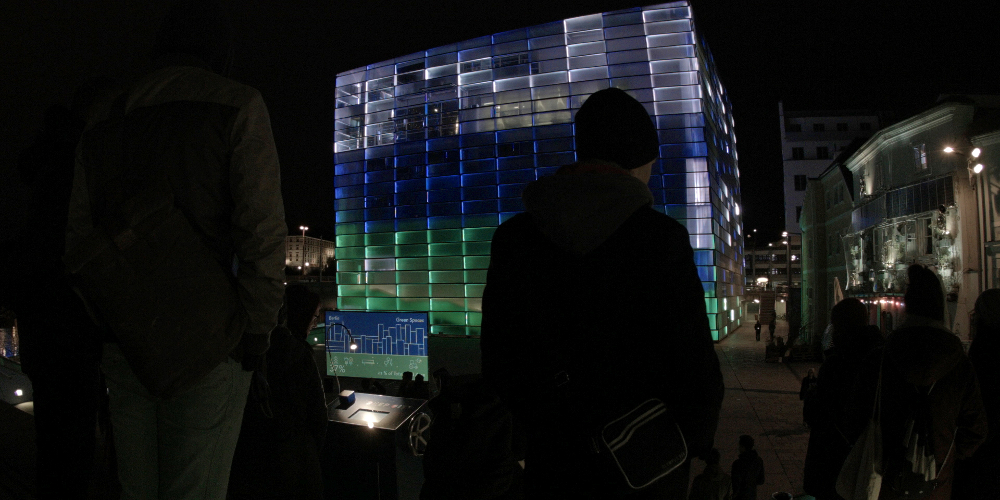
Deep City is a data visualization experiment investigating the collective information that defines a city’s present and future. Findings from Linz, Vienna, Berlin, and New York are represented as visualized data layers and displayed on the four sides of the Ars Electronica Center building. 8 data sets that explore the tension between individuals, spaces, and resources were chosen and grouped into pairs: Growth / Diversity, Green Spaces / Bike Paths, Water Usage / Waste, and Density / Noise Exposure. By comparing the data sets, assumptions about individual behaviors and social customs can be explored and challenged.
Returning information
Ursula Feuersinger (AT) designed and constructed an interactive terminal to return the data to its source, the urban population, for reconsideration and evaluation. Observers of the project become participants, extracting hidden artifacts from the deep and bringing them to the surface. A crank allows participants to browse through color-coded topologic layers. When users pause on a given color, animated content is revealed, both on the Ars Electronica Center façade and on the terminal’s screen. The second interaction element is a 3D printed cube, a hand-sized, miniature model of the AEC building. By rotating the cube on the interface terminal, users can switch from one city to another and view the respective city’s content.
Deep City Video
Camera: Benjamin Skalet (DE), Claudia Schnugg (AT), Veronika Pauser (AT), Sigrid Nagele (AT)
Editing: Christian Haas (AT), Ursula Feuersinger (AT)
Design, Animation: Ursula Feuersinger (AT)
Sound: Richard Eigner, Roman Gerold (Ritornell/AT)
Technical Support: Leonard Pokropek (AT)
The Connecting Cities Research Residencies have been realized at the Ars Electronica Futurelab with the support of the Ars Electronica Residency Network.
Ars Electronica Blog
“Beneath the city, there are various layers that you can’t immediately see at first glance. These strata contain information that provides detailed and comprehensive descriptions of our coexistence and its framework circumstances.” Read more on the Ars Electronica Blog!
Connecting Cities is initiated by Public Art Lab in cooperation with Ars Electronica Futurelab Linz, Medialab-Prado Madrid, FACT Liverpool, Videospread Marseille, iMAL Brussels, Riga 2014, BIS Istanbul, m-cult Helsinki, Media Architecture Institute Vienna, Museum of Contemporary Art Zagreb, in association with Aarhus University, Marseille-Provence 2013, MUTEK Montreal, Quartier des Spectacles Montreal, Foundation Bauhaus Dessau, Verve Cultural Sao Paulo, Federation Square Melbourne, xm:lab Saarbrücken, Sapporo Media Arts Lab, ETOPIA Zaragoza, The Concourse Sydney and 403 International Arts Center Wuhan.
With support of the Culture Programme 2007-2013 of the European Union.
Find more information on www.connectingcities.net

